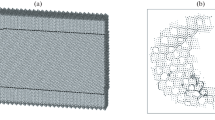Abstract
A model that allows calculating the effective charge of native and impurity ions during electromigration at the tilt grain boundary of metal is proposed for the first time. It is considered in the model that the main factor resulting in the difference in the values of the effective charge during electromigration at the boundary and in the volume of the monocrystal is the difference in their atomic densities. It has an effect on the electron wind force determining the value of the effective charge. In this work, the procedure of calculating the form-factors of ions is improved to carry out the specified calculations, and also the model approximations enabling us to relate the atomic density at the tilt grain boundary with the parameters of its structure are developed. The effective charges of aluminum and copper ions at the grain boundary of aluminum as a function of the grain boundary’s misorientation angle, texture of the grains forming the boundary, and temperature are calculated in the model.


Similar content being viewed by others
REFERENCES
Fiks, V.B., Ionnaya provodimost’ v metallakh i poluprovodnikakh (Ion Conductivity in Metals and Semiconductors), Moscow: Nauka, 1969.
Valiev, K.A., Goldstein, R.V., Zhitnikov, Yu.V., Makhviladze, T.M., and Sarychev, M.E., Nano- and micrometer-scale thin-film-interconnection failure theory and simulation and metallization lifetime prediction, Part 1: A general theory of vacancy transport, mechanical-stress generation, and void nucleation under electromigration in relation to multilevel-metallization degeneration and failure, Russ. Microelectron., 2009, vol. 38, no. 6, pp. 364–384.
Sorbello, R.S., A pseudopotential based theory of the driving forces for electromigration in metals, J. Phys. Chem. Solids, 1973, vol. 34, no. 3, pp. 937–950.
Ceric, H. and Selberherr, S., Electromigration in submicron interconnect features of integrated circuits, Mater. Sci. Eng., R, 2011, vol. 71, nos. 5–6, pp. 53–86.
Ziman, J., Principles of the Theory of Solids, Cambridge: Cambridge Univ. Press, 1976.
Animalu, A.O.E., Intermediate Quantum Theory of Crystalline Solids, New Jersey: Englewood Cliffs, 1977.
Babichev, A.P., Babushkina, N.A., Bratkovskii, A.M., et al., Fizicheskie velichiny: Spravochnik (Physical Values. The Handbook), Grigor’ev, I.S. and Melikhov, E.Z., Eds., Moscow: Energoatomizdat, 1991.
Harrison, W.A., Pseudopotentials in the Theory of Metals, New York, Amsterdam: W.A. Benjamin, 1966.
Harrison, W.A., Model pseudopotential and Kohn effect in lead, Phys. Rev., 1965, vol. 139, no. 1A, pp. A179–A185.
Dagens, L., The resonant model, potential form factor: general theory and application to copper, silver and calcium, J. Phys. F: Met. Phys., 1976, vol. 6, no. 10, pp. 1801–1817.
Heine, V. and Abarenkov, I., A new method for the electronic structure of metals, Philos. Mag., 1964, vol. 9, no. 99, pp. 451–465.
Abarenkov, I.V. and Heine, V., The model potential for positive ions, Philos. Mag., 1965, vol. 12, no. 117, pp. 529–537.
Hubbard, J., Description of the collective movements in the many particle system by disturbance theory methods. II. The correlation energy of the free electron gas, Proc. R. Soc., Ser. A, 1958, vol. 243, no. 1, p. 336.
Singwi, K.S., Tosi, M.P., and Land, R.H., Electron correlations at metallic densities, Phys. Rev., 1968, vol. 176, no. 2, pp. 589–599.
Animalu, A.O.E. and Heine, V., The screened model potential for 25 elements, Philos. Mag., 1965, vol. 12, no. 120, pp. 1249–1270.
Taut, M. and Paasch, G., The charge of model potentials in alloying, Phys. Status Solidi B, 1972, vol. 51, no. 1, pp. 295–306.
Heine, V. and Weaire, D., Pseudopotential theory of cohesion and structure, Solid State Phys., 1970, vol. 24, pp. 295–543.
Li, J.C.H., High-angle tilt boundary—a dislocation model, J. Appl. Phys., 1961, vol. 32, no. 3, pp. 525–542.
Van der Merve, J.H., On the stress and energies associated with intercrystalline boundaries, Proc. Phys. Soc., Ser. A, 1950, vol. 3, no. 3, pp. 616–637.
Harrison, W.A., Electron structure of a series of metals, Phys. Rev., 1963, vol. 131, no. 6, pp. 2433–2442.
Tu, K.N. and Gupta, T., Def. Diff. Forum, 1993, vols. 95–97, pp. 257–262.
Sarychev, M.E., Zhitnikov, Yu.V., Borucki, L., Liu, C.-L., and Makhviladze, T.M., A new, general model for mechanical stress evolution during electromigration, Thin Solid Films, 2000, vol. 365, pp. 211–218.
Wang, P.C., Cargill III, G.S., Noyan, L.C., and Hu, C.-K., Electromigration-induced stress in aluminum conductor lines measured by X-ray microdiffraction, Appl. Phys. Lett., 1998, vol. 72, no. 11, pp. 1296–1298.
Dekker, J.P. and Lodder, A., Theory electromigration wind force in dilute alloys, Phys. Rev., vol. 56, no. 19, pp. 12167–12177.
Funding
The work is carried out as part of a state task for Valiev Institute of Physics and Technology of the Russian Academy of Sciences of the Ministry of Education and Science of the Russian Federation, project no. 0066-2019-0004.
Author information
Authors and Affiliations
Corresponding author
Additional information
Translated by G. Levina
Rights and permissions
About this article
Cite this article
Makhviladze, T.M., Sarychev, M.E. Simulation of the Effect of the Grain Boundary Structure on Effective Ionic Charges in the Processes of Electromigration. Russ Microelectron 48, 373–380 (2019). https://doi.org/10.1134/S106373971905007X
Received:
Revised:
Accepted:
Published:
Issue Date:
DOI: https://doi.org/10.1134/S106373971905007X




